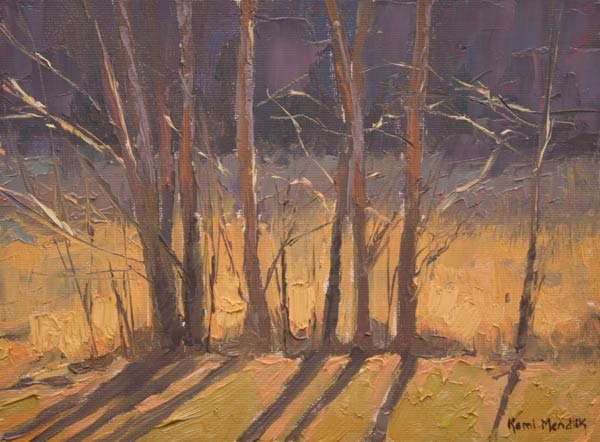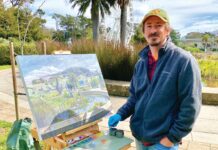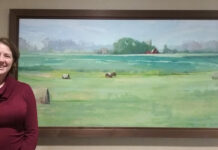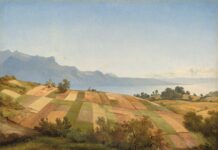Kami Mendlik appreciates travel. She loves to paint beautiful places. But one part of the country has a subtle beauty that can make her emotional.
“I’m excited every day to go out and see what is happening in the wetlands,” she says. Mendlik is talking about the wetlands on her property, 15 acres of land that locals thought she was crazy for buying because there wasn’t enough lumber to cut, nor enough arable land to farm. “It’s worthless? It’s worth even more to me,” she says. “This is what I love, and this is truly what grabs my curiosity. I can spend hours on end, every day, in a ditch.”

“Sweet Softness,” by Kami Mendlik, oil on panel, 6 x 8 in.
Her land is home to the St. Croix River School of Painting, actually located a few miles off the St. Croix River in Minnesota, near Stillwater. The area is popular among folks in the Twin Cities interested in getting away from urban life in the summer. Mendlik’s land is mostly wetland, a haven for birds, with some old pines lining the driveway and a 150-year-old barn serving as a studio.

“A New Direction,” by Kami Mendlik, oil on panel, 6 x 6 in.
“This area, this terrain, is where I grew up,” says Mendlik. “I’m new to this particular place — this will be our second summer here — but it’s also familiar. I grew up on a 400-acre farm just north of Stillwater. I spent my days out on the property, wandering, hanging out with horses, exploring. I was outside from first thing in the morning until a minute after dark. I did the things that I thought were normal for little girls to do — catch tadpoles, dig up worms, dig up plants and hang them up to dry. I was seriously curious about the natural world. That was embedded in me. And I still am.”

“Country Road,” by Kami Mendlik, oil on panel, 8 x 10 in.
The St. Croix River has proved crucial to Mendlik in her life. Despite her talent, she was discouraged from pursuing a career as an artist in high school because it wasn’t considered practical. In her 20s, she fixed on art nonetheless, carving out time to work from life on the banks of the St. Croix. “I went every single day,” she says. “That is how I got deeply embedded and emotionally connected to the river. The more I went, the more humble I became. I stared at the water and tried to figure it out. The river became a big part of me as a painter, and I feel like it taught me.”

“Tender Morning Light,” by Kami Mendlik, oil on panel, 8 x 6 in.
She found gallery success and started the St. Croix River School of Painting, and now the school has a new home — her home. The property is already a favorite spot for artistic types in the area. On Monday nights, painters, writers, and musicians gather around the ruins of an old silo — the fieldstone foundation is all that’s left — and socialize and create.

“From the Studio Window,” by Kami Mendlik, oil on panel, 18 x 24 in. Studio piece
Mendlik loves the landscape she grew up knowing, but it’s different now that she owns her tract of land. She says she sees it differently, and appreciates it more. When she goes on trips, she can always imagine herself living wherever she’s staying. But as the trip winds down, she wearies of the new sights, and thinks of home. After a recent trip to the beautiful West Coast, she arrived back in Minnesota a bit tired. Her son wanted to pick up some corn at her dad’s farm, just six miles away. Mendlik agreed, and they piled into her truck and traversed the ochre ground, through the grays and greens of the overcast day. “It was a somber, wet, cool Minnesota day,” she recalls. “Driving out there, I got an incredibly strong sense of peace, like warm water pouring over my body. It was something greater, something telling me that this subtle, sophisticated beauty is what I need to paint. This is home.”

Kami Mendlik’s property in the St. Croix River Valley in Minnesota
Mendlik has lived and painted this area all her life, but she says she won’t tire of it. “I’m never bored,” says the artist. “I hope to live to be 100 so I can get to do what I want to do every day. The artist has to be interested. It has nothing to do with the scene. It has to do with the curiosity. We get grounded in fundamentals and do so much studying about what a painter has to do to get the skills, but then there’s something more, the subconscious. We confront what needs to be in the painting and what doesn’t need to be in the painting. We get to the point where we make a statement, transfer the emotion.”





That is really fascinating, You are an excessively skilled blogger.
I’ve joined your feed and sit up for seeking extra
of your fantastic post. Also, I’ve shared your site in my social networks